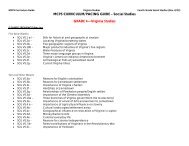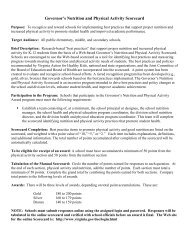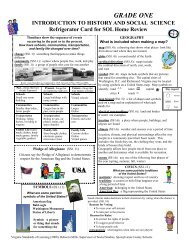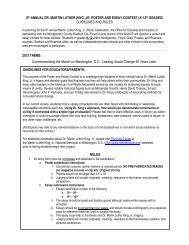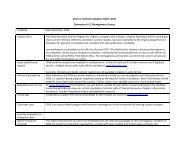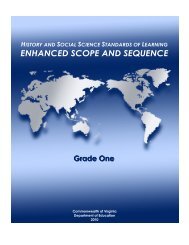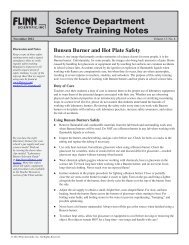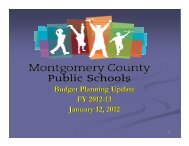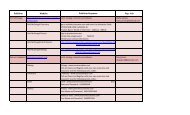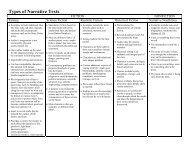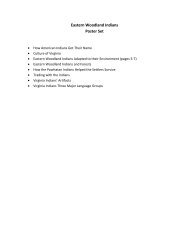Holt McDougal Physics
Holt McDougal Physics
Holt McDougal Physics
You also want an ePaper? Increase the reach of your titles
YUMPU automatically turns print PDFs into web optimized ePapers that Google loves.
<strong>Holt</strong> <strong>McDougal</strong> <strong>Physics</strong><br />
Science Textbook Adoption Rubric 2011<br />
Secondary 9-12, Montgomery County<br />
Textbook<br />
<strong>Holt</strong> <strong>McDougal</strong> <strong>Physics</strong> balances a conceptual study of physics with quantitative problem solving that is<br />
demonstrated in consistent, four-step method. This method provides students with a framework that helps<br />
them solve problems effectively, from identifying givens and unknowns and making a diagram, to<br />
evaluating the answer. The robust lab program helps develop an understanding of scientific inquiry,<br />
concepts and experimentation, and provides comprehensive skills practice for students. This<br />
comprehensive text is designed for use in a single academic year. The program supports the teaching<br />
and learning of all state standards through reading support and accompanying visuals, interactive<br />
presentation materials, inquiry-driven lab activities, data analysis activities, problem solving and critical<br />
thinking skills, and comprehensive assessment opportunities. Teachers and students will benefit from<br />
user-friendly resources that allow all levels of learners to master physics.<br />
• ©2012<br />
• Balances a conceptual study of physics with quantitative problem solving in an accessible format<br />
• Strongest problem-solving support<br />
• Ongoing skills support (See extensive problem solving support)<br />
• Abundance of referenced online multimedia and digital tools to help students comprehend physic<br />
concepts: Virtual investigations, Interactive Demos, Animated <strong>Physics</strong>, and STEM features<br />
• Differentiation at-point-of-use in TE wrap to address all learners<br />
• Features to engage learners and make <strong>Physics</strong> relevant: Why It Matters, <strong>Physics</strong> on the Edge,<br />
Careers in <strong>Physics</strong>, and STEM activities<br />
• Ongoing Formative Assessment: Frequent comprehension checks during and after lesson; online<br />
section reviews.<br />
Virginia SOL’s<br />
Correlation available on request<br />
Audio book/closed<br />
caption<br />
• Chapter audio files: summaries of each chapter in English. Available at-point-of use online at<br />
HMDScience.com. (downloadable)
Historical perspective • TIMELNE feature is strategically placed in appropriate chapters: See SE pg 150 for example.<br />
Book/Resources on<br />
line<br />
Virtual labs<br />
• All program resources are located online at my.hrw.com. For a complete list of all resources see<br />
pg. 2 in the <strong>Physics</strong> Program Overview. Resources are located at point of use by Chapter and<br />
section making it a user-friendly platform for both students and teachers.<br />
Virtual labs are included on a stand –alone cd-rom. Provides meaningful experiments in a lab simulation<br />
without the expense, time, or risk of traditional lab.<br />
Classroom Labs • Wide variety of labs to give teachers flexibility to pick and choose the ones that meet classroom<br />
needs: Quick, Core Skills, Standard Chapter Labs, Stem, Open-Inquiry, and STEM<br />
• To cut down on size of text Quick Labs only in Student Editions, all lab choices referenced in<br />
Student and Teacher edition at point-of-use<br />
Quantity of graphics<br />
in evaluation tools<br />
Nature of Science<br />
materials<br />
Digital resources<br />
online and on DVD<br />
Instructional/editable<br />
powerpoints<br />
Study guides for the<br />
textbook<br />
Active reading guides<br />
• Instructional Visuals in Formative Assessments See example: pp. 55, 61,<br />
• See Chapter Review and Standards-Based Assessment pp. 70-77.<br />
• Teach with Visuals in TE wrap for most graphics.<br />
• See variety of test questions at point of use on HMDScience.com<br />
Nature of science as defined by the introduction to the VA <strong>Physics</strong> SOLs are woven throughout the<br />
program:<br />
• See for example Chapter 1 and Why It Matters features throughout the text.<br />
• Understanding that students also learn the nature of science by doing science, <strong>Physics</strong><br />
incorporates inquiry throughout the program. With features like Virtual Labs and the most<br />
comprehensive lab program available including Open-Inquiry and STEM Labs, students are asked<br />
to think like scientists as they uncover evidence and analyze data. All of the labs are located at<br />
point of use at HMDScience.com.<br />
The wide variety of technology resources provides easy 24/7 access to program materials for both<br />
teachers and students. All of the student and teacher program resources are included at point of use<br />
online: eBooks, worksheets labs, assessment, and multimedia resources. Most of the program<br />
components are also included in a CD or DVD format. These resources were specifically designed to<br />
make the content of the program more accessible to students and to aid teachers in the planning,<br />
teaching, reviewing, and assessing the vocabulary and concepts.<br />
• See Power Presentations at point of use on my.hrw.com. These pre-built, editable files offer an<br />
engaging, editable multimedia presentation and student note-taking worksheets for every lesson<br />
in the text –save teachers valuable preparation time.<br />
• Each chapter presentation is offered in both OUTLINE and INQUIRY style<br />
• There are Section Study Guides found at point of use online at HMDScience.com<br />
• There are Chapter Study Guides found at point of use online at HMDScience.com<br />
Teacher Edition strategies in the TE wrap provides strategies for students to use as they read:
Quality of graphic<br />
organizers/concept<br />
maps (examples)<br />
Vocabulary<br />
reinforcement<br />
Reading Level • Dale-Chall with<br />
End-of-Chapter<br />
checkup/review<br />
Differentiated<br />
strategies<br />
5-E Lesson Model<br />
Engagement,<br />
Exploration,<br />
Explanation,<br />
Elaboration,<br />
Evaluation<br />
Real world<br />
connections<br />
• Demonstrations: See for example p. 81<br />
• Problem Solving: See for example p. 82<br />
• Differentiated Instruction—Below Level: See p. 90<br />
• Teach From Visuals: See p. 100<br />
• Differentiated Instruction—Inclusion: See p. 100<br />
Concept maps found at point of use in each chapter at HMDScience.com<br />
• The student edition has been redesigned to assist students with more vocabulary support.<br />
• Definitions of new vocabulary at point of use.<br />
• Visuals reinforce new vocabulary and ideas<br />
• With focused reading in shorter chunks of material, students can more easily grasp the Main<br />
Ideas<br />
• Sample problems have been redesigned to boost student understanding. See pg.51<br />
• Interactive Demos are at point of use and found on HMDScience.com<br />
technical vocabulary = 11.2<br />
• Dale-Chall without technical vocabulary = 10.4<br />
• Lexile= 1090<br />
End of Chapter materials include:<br />
• Key concept Summary<br />
• Question Review includes; Reviewing Main Ideas, Conceptual questions, practice problems,<br />
Graphing Calculator practice, Alternative Assessments, and Standards- Based Assessments<br />
• Interactive Review : online and includes Concept map and Puzzle Pro<br />
• Every chapter includes Differentiated Instruction for Below Level, Pre-AP, English Learners and<br />
Inclusion Students.<br />
• Instruction and Interventions support at beginning of each chapter. See pages 34A and B<br />
• Challenges at point of use.<br />
All components of <strong>Holt</strong> <strong>McDougal</strong> <strong>Physics</strong> are designed to fit easily within the 5 –E Lesson Model.<br />
• Engage: Teacher Edition Chapter Opener, Focus and Motivate Features, Why it Matters,<br />
• Explore: labs, Visual Concepts, Animated <strong>Physics</strong>, and Virtual labs<br />
• Explain: Differentiated Instruction Strategies in TE, Power Presentations, Teaching Visuals, at<br />
point of use strategies throughout the Teachers Edition margins<br />
• Elaborate: STEM labs, <strong>Physics</strong> on the Edge, and Web-links<br />
• Evaluate: Wide variety of assessment tools to diagnose, evaluate, and remediate.<br />
• Why it Matters at the beginning of each chapter and at significant points within chapter.<br />
• Web links<br />
• Sample problems are designed around real world applications<br />
• Careers in <strong>Physics</strong><br />
Test banks • The program includes Exam View, which includes the many existing <strong>Physics</strong> assessments as well
as an additional bank of questions for teachers who are interested in further expanding and<br />
customizing their assessment. Using Exam View, teacher can edit questions or add their own.<br />
• Online Assessment and Remediation allows teachers to create and assign tests which are<br />
automatically graded. Remediation using materials from the program is prescribed to students not<br />
mastering concepts. A post-test is offered to determine student mastery<br />
Graphics Bank • Power presentations include many images from the test.<br />
• Teaching Visuals and Interactive Whiteboard Resources located at Teacher Resources tab on<br />
HMDScience.com<br />
Formative<br />
Assessments<br />
Summative<br />
Assessments<br />
Depth of information<br />
on SOL concepts<br />
Misconception<br />
research notes<br />
Questions using<br />
higher levels of<br />
Bloom’s Taxonomy<br />
Concrete connections<br />
to VA. SOL test<br />
Computer assisted<br />
instruction<br />
• Formative Assessment at the end of each section checks for understanding of Main Ideas and<br />
provides opportunities for critical thinking and connections of Main Ideas.<br />
• The Teacher Edition also provides a variety of ongoing formative assessment options. See<br />
examples of Teach with Visuals and Activate Prior Knowledge features<br />
• Sample Problem Sets I and II located at point of use on HMDScience.com<br />
Throughout the program, assessments are scaffolded to provide access for all levels of learners. At the<br />
end of each section in the Teacher Edition there are suggestions for additional section assessment<br />
options and re-teaching strategies for students needing additional help.<br />
The assessment options include:<br />
• Section Quizzes<br />
• Leveled Chapter Tests<br />
See correlation<br />
Every chapter includes Misconception Alert feature, which highlights a common misconception and a<br />
strategy for correcting the misconception right at point of use in the Teacher Editions wrap margin<br />
Evidence of higher order thinking questions can be found throughout the program<br />
• Critical Thinking in Section Assessments<br />
• Conceptual Questions in Chapter Review<br />
• Problem Solving Take It Further features in TE wrap margin<br />
• Differentiated Instruction—Pre AP strategies in TE wrap margin<br />
See two page Standards-Based Assessment at the end of each chapter in the Student Edition.<br />
<strong>Holt</strong> <strong>McDougal</strong> <strong>Physics</strong> has may online components that allow student to progress at their own pace and<br />
work individually or problem solve in a group. The program also includes components that provide<br />
immediate feedback, letting student know whether their answer is correct. For examples of computer<br />
assisted instruction see:<br />
• Animations and Simulations – Animated <strong>Physics</strong> and Visual Concepts<br />
• Virtual Labs
Experiential learning<br />
strategies/ kits<br />
Lessons broken into<br />
short discrete<br />
elements<br />
Help online<br />
• Interactive Review: Concept Maps<br />
• WebLinks<br />
To support the comprehensive lab program described above, Supplemental Teaching Materials located<br />
at HMDScience.com include a wide variety of resources to help teach the laboratory skills. Some of the<br />
resources include:<br />
• Classroom Management Resources<br />
• Laboratory Manager’s Professional Manual<br />
• Professional Reference for Teachers<br />
Content of each lesson is organized around Main idea providing a research-based framework to help<br />
students build understanding and retain more information. Each main Idea chunk is supported by<br />
instructional visuals and teaching strategies to help students grasp vocabulary and concepts. The Main<br />
Ideas are reviewed in the Section Formative Assessment and Chapter Review.<br />
Teachers can email tech support at techsuport@hmhpub.com. At this website there are frequently asked<br />
questions that might help address issues. From 8:00am-11:00pm EST teachers can also call tech support<br />
at 800-323-9239



